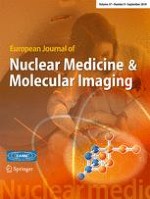Published in:

01-08-2010 | Original Article
Time-of-flight PET/CT using low-activity protocols: potential implications for cancer therapy monitoring
Authors:
Iain Murray, Antonis Kalemis, Joe Glennon, Syed Hasan, Shuaib Quraishi, Thomas Beyer, Norbert Avril
Published in:
European Journal of Nuclear Medicine and Molecular Imaging
|
Issue 9/2010
Login to get access
Abstract
Introduction
Accurate quantification of tumour tracer uptake is essential for therapy monitoring by sequential PET imaging. In this study we investigated to what extent a reduction in administered activity, synonymous with an overall reduction in repeated patient exposure, compromised the accuracy of quantitative measures using time-of-flight PET/CT.
Methods
We evaluated the effect of reducing the emission count statistics, using a 64-channel GEMINI TF PET/CT system. Experiments were performed with the NEMA IEC body phantom at target-to-background ratios of 4:1 and 10:1. Emission data for 10 s, 30 s, 1 min, 2 min, 5 min and 30 min were acquired. Volumes of interest fitted to the CT outline of the spheres were used to calculate recovery coefficients for each target-to-background ratio and for different reconstruction algorithms. Whole-body time-of-flight PET/CT was performed in 20 patients 62±4 min after injection of 350±40 MBq (range 269–411 MBq) 18F-FDG. From the acquired 2 min per bed position list mode data, simulated 1-min, 30-s and 15-s PET acquisitions were created. PET images were reconstructed using the TOF-OSEM algorithm and analysed for differences in SUV measurements resulting from the use of lower administered activity as simulated by reduced count statistics.
Results
In the phantom studies, overall we identified no significant quantitation bias over a wide range of acquired counts. With acquisition times as short as 10 s, lesions as small as 1 cm in diameter could still be identified. In the patient studies, visual analysis showed that emission scans as short as 15 s per bed position sufficiently identified tumour lesions for quantification. As the acquisition time per bed position decreased, the differences in SUV quantification of tumour lesions increased relative to the 2-min reference protocol. However, SUVs remained within the limits of reproducibility required for therapy monitoring. Measurements of SUVmean within the region of interest were less prone to noise than SUVmax, and with the 30-s per bed position 95% confidence limits were ±11% or ±0.7 SUV.
Conclusion
Short time acquisitions, synonymous with reduced injected activity, performed on a TOF-based PET/CT system are feasible without encountering significant bias. This could translate into clinical protocols using lower administered activities particularly for serial PET studies.